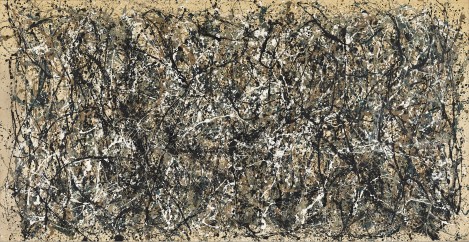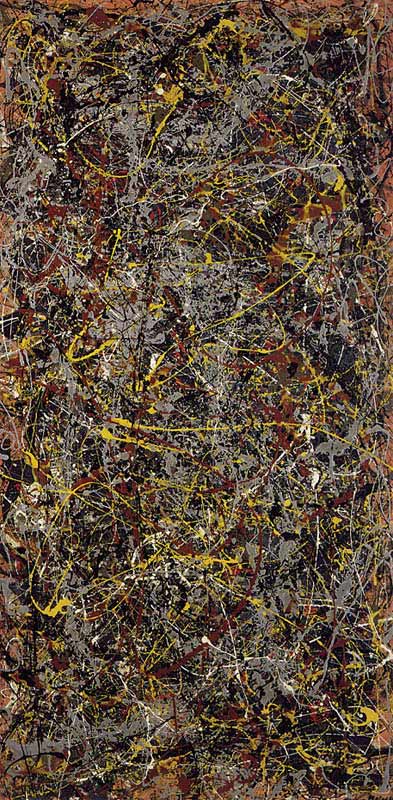I long ago stumbled across the fascination that Jackson Pollock’s art work exerts over physicists but this work from Brown University adds some colours to the picture (wordplay intended).

From an October 30, 2019 Brown University news release (also on EurekAlert),
The celebrated painter Jackson Pollock created his most iconic works not with a brush, but by pouring paint onto the canvas from above, weaving sinuous filaments of color into abstract masterpieces. A team of researchers analyzing the physics of Pollock’s technique has shown that the artist had a keen understanding of a classic phenomenon in fluid dynamics — whether he was aware of it or not.
In a paper published in the journal PLOS ONE, the researchers show that Pollock’s technique seems to intentionally avoid what’s known as coiling instability — the tendency of a viscous fluid to form curls and coils when poured on a surface.
“Like most painters, Jackson Pollock went through a long process of experimentation in order to perfect his technique,” said Roberto Zenit, a professor in Brown’s School of Engineering and senior author on the paper. “What we were trying to do with this research is figure out what conclusions Pollock reached in order to execute his paintings the way he wanted. Our main finding in this paper was that Pollock’s movements and the properties of his paints were such he avoided this coiling instability.”
Pollock’s technique typically involved pouring paint straight from a can or along a stick onto a canvas lying horizontally on the floor. It’s often referred to as the “drip technique,” but that’s a bit of a misnomer in the parlance of fluid mechanics, Zenit says. In fluid mechanics, “dripping” would be dispensing the fluid in a way that makes discrete droplets on the canvas. Pollock largely avoided droplets, in favor of unbroken filaments of paint stretching across the canvas.
In order to understand exactly how the technique worked, Zenit and colleagues from the Universidad Nacional Autonoma de Mexico analyzed extensive video of Pollock at work, taking careful measure of how fast he moved and how far from the canvas he poured his paints. Having gathered data on how Pollock worked, the researchers used an experimental setup to recreate his technique. Using the setup, the researchers could deposit paint using a syringe mounted at varying heights onto a canvas moving at varying speeds. The experiments helped to zero in on the most important aspects of what Pollock was doing.
“We can vary one thing at a time so we can decipher the key elements of the technique,” Zenit said. “For example, we could vary the height from which the paint is poured and keep the speed constant to see how that changes things.”
The researchers found that the combination of Pollock’s hand speed, the distance he maintained from the canvas and the viscosity of his paint seem to be aimed at avoiding coiling instability. Anyone who’s ever poured a viscous fluid — perhaps some honey on toast — has likely seen some coiling instability. When a small amount of a viscous fluid is poured, it tends to stack up like a coil of rope before oozing across the surface.
In the context of Pollock’s technique, the instability can result in paint filaments making pigtail-like curls when poured from the can. Some prior research had concluded that that the curved lines in Pollock’s paintings were a result of this instability, but this latest research shows the opposite.
“What we found is that he moved his hand at a sufficiently high speed and a sufficiently short height such that this coiling would not occur,” Zenit said.
Zenit says the findings could be useful in authenticating Pollock’s works. Too many tight curls might suggest that a drip-style painting is not a Pollock. The work could also inform other settings in which viscous fluids are stretched into filaments, such as the manufacture of fiber optics. But Zenit says his main interest in the work is that it’s simply a fascinating way to explore interesting questions in fluid mechanics.
“I consider myself to be a fluid mechanics messenger,” he said. “This is my excuse to talk science. It’s fascinating to see that painters are really fluid mechanicians, even though they may not know it.”
Here’s a link to and a citation for the paper,
Pollock avoided hydrodynamic instabilities to paint with his dripping technique by Bernardo Palacios, Alfonso Rosario, Monica M. Wilhelmus, Sandra Zetina, Roberto Zenit. PLOS ONE DOI: https://doi.org/10.1371/journal.pone.0223706 Published: October 30, 2019
This paper is open access.
I could not find any videos related to this research that I know how to embed but Palacios, Zetina, and Zenit have investigated Polock’s ‘physics’ before,
If you want to see Pollock dripping his painting in action, there’s a 10 min. 13 secs. film made in 1950 (Note: Links have been removed from text; link to 10 min. film is below),
In the summer of 1950, Hans Namuth approached Jackson Pollock and asked the abstract expressionist painter if he could photograph him in his studio, working with his “drip” technique of painting. When Namuth arrived, he found:
“A dripping wet canvas covered the entire floor. Blinding shafts of sunlight hit the wet canvas, making its surface hard to see. There was complete silence…. Pollock looked at the painting. Then unexpectedly, he picked up can and paintbrush and started to move around the canvas. It was as if he suddenly realized the painting was not finished. His movements, slow at first, gradually became faster and more dancelike as he flung black, white and rust-colored paint onto the canvas.”
The images from this shoot “helped transform Pollock from a talented, cranky loner into the first media-driven superstar of American contemporary art, the jeans-clad, chain-smoking poster boy of abstract expressionism,” one critic later wrote in The Washington Post.
You can find the film and accompanying Open Culture text intact with links here.

